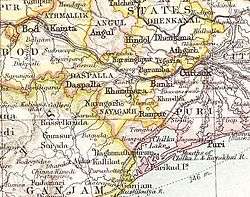Nayagarh State
| Nayagarh State ନୟାଗଡ଼ / नयागढ़ | |||||
| Princely State of British India | |||||
| |||||
|
Flag | |||||
 | |||||
| History | |||||
| • | Established | c. 1500 | |||
| • | Accession to the Union of India | 1948 | |||
| Area | |||||
| • | 1931 | 1,528 km2 (590 sq mi) | |||
| Population | |||||
| • | 1931 | 142,406 | |||
| Density | 93.2 /km2 (241.4 /sq mi) | ||||
| | |||||
Nayagarh State (Odia: ନୟାଗଡ଼; Hindi: नयागढ़) was one of the princely states of India during the period of the British Raj. It was located in present-day Nayagarh district, Odisha.
The state was bounded in the north by Khandpara State and Puri District. The capital was at Nayagarh. The southern part of the state was forested and mountainous and was inhabited mainly by Khonds.[1]
History
Nayagarh was founded before 1550 by Raja Surya Mani, a scion of the Rewa Royal Family.[2] Khandpara State was initially part of Nayagarh State, but became a separate kingdom in 1599. The rulers were Rajputs of the Baghela or Vaghela dynasty. The last Raja of Nayagarh signed the instrument of accession to the Indian Union on 1 January 1948.[3]
Epic events
The story of the foundation of Nayagarh State is an important chapter in the political history of Odisha. Surya Mani of the Baghela dynasty came to Puri on a pilgrimage from Rewa of Madhya Pradesh and established his kingdom at Nayagarh. On the way to Puri, Both Surya Mani and his brother Chandramani rested at Gunanati for the night. The area was full of tigers and at night one of them attacked him. Both brothers fought the tiger and killed it. The local people praised the brave brothers and elected Surya Mani as their leader. Surya Mani gradually built his fort at Gunanati and married a Mali girl.
After the death of his first wife Surya Mani married again, this time a Kshatriya girl. From Gunanati he then attacked Haripur and Ralaba,a beautiful place. While sleeping a tiger attacked him at Ralaba he again fought and killed it. At that moment he saw a lady passing by with an empty pot to fetch water. Astonishingly, she returned with a little boy. Immediately, Surya Mani obstructed the way of that lady and wanted to know about the mystery. The lady told she was Bouri Thakurani, a local goddess, and the tiger that the king had killed was the boy. She advised Surya Mani to kill her and worship her as his deity. From that date Surya Mani worshiped Bauri Thakurani at Ralaba and built his fort there and adopted the tiger head as a state symbol.
Bagel Singh (1480–1510), the Ninth king of the dynasty came on a hunting to a place in between Rukshi and the Balaram mountains and saw a wonderful sight that a rabbit pressed down a dog there. After seeing this he selected and shifted his capital to this place. As per his name this place was known as "Baghua Nayagarh". The place where such an event occurred is now known as "Kukur Tasara".
The 12th King of Nayagarh Raghunath Sing (1565–1595) was highly powerful. During this time Muslims had already captured Odisha and coastal Odisha was in a state of anarchy. Last independent king Mukunda Dev (1565) was defeated in Gohritikira and died. By taking advantage of the political situations of coastal Odisha, Raghunath Singh attacked Ranpur and captured Odagaon, Sarankul and Baunsiapara area from Ranpur State and dispossessed Nayagarh-Daspalla border area from the King of Boudh and Sunamuhin area of Odgaon from the King of Ghumusar. He also captured a portion from Banpur. Before death, Ragunath Singh divided his estate between his three sons. Harihar Singh was in possession of Nayagarh and Jadunath Singh got four Khandagrams (large area of land) which was known as Khandapada later. Gadadhar Singh was the son of Harihar Singh. When he was engaged in a fight with Ranpur State the king of Ghumusar attacked Nayagarh. Pindik Patsahani of village Sunalati with 150 soldiers fought the great army of Ghumusar and defeated him. But, in subsequent war he was captured by the enemy and sacrificed his life. Gadadhar Sing's daughter married the great poet Upendra Bhanja of Ghumusar who settled at Malisahi of Nayagarh State after marriage. When the British captured Odisha, Binayak Singh was the King of Nayagarh and the great Jadumani Mahapatra was his poet.
Rulers
The rulers of Nayagarh State bore the title of Raja. The emblem of the Nayagarh royal family was the head of a tiger, the same state symbol as that of the rulers in neighbouring Khandpara State.[4]
Rajas
- .... - .... Chandrasekhar Singh Mandhata
- .... - .... Purushottam Singh Mandhata
- .... - 1784 Mrutyunjay Singh Mandhata
- 1784 - 1825 Binayak Singh Mandhata
- 1825 - 1851 Braja Babdhu Singh Mandhata
- 20 Sep 1851 - 1889 Ladhu Kishor Singh Mandhata (b. c.1843 - d. ....)
- 1889 - 1890 Balbhadra Singh
- 2 Mar 1890 - 4 Sep 1897 Raghunath Singh Mandhata
- 1897 - 7 Dec 1918 Narayan Singh Mandhata
- 7 Dec 1918 - 15 Aug 1947 Krishnachandra Singh Mandhata (b. 1911 - d. 1983)
See also
References
- ↑ Great Britain India Office. The Imperial Gazetteer of India. Oxford: Clarendon Press, 1908.
- ↑ Nayagarh (Princely State)
- ↑ Rajput Provinces of India - Nayagarh (Princely State)
- ↑ Princely States of India
Coordinates: 20°08′N 85°06′E / 20.13°N 85.1°E
